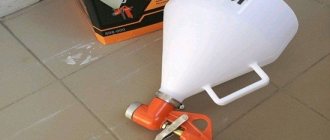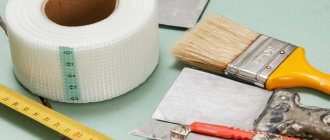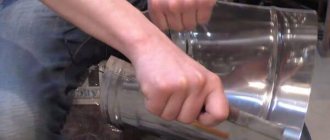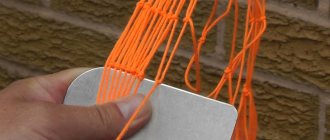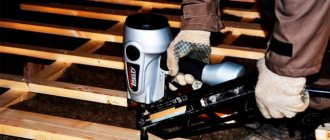Which compressor is best to use for plastering walls?
In professional technologies for plastering walls, preference is given to a mechanized method of applying the solution using an air compressor.
On its basis, a plastering station is assembled, with the help of which the productivity and quality of work is significantly increased, and their cost is reduced. By mechanized means, rough and finishing mixtures are supplied over long distances horizontally and vertically. Professionals use both piston and screw models for this. Which compressor is best for plastering walls is determined taking into account operating conditions and the volume of work. Since compressed air is supplied directly to the nozzle and is needed only for spraying the solution, in most cases preference is given to installations of small mass and productivity, and the decision is influenced by the resource of the equipment.
Advantages of using small compressors:
- minimizing solution losses that occur under excess pressure;
- reduction in investment and cheaper production;
- convenient and easy movement around the work site;
- possibility of applying the composition in one pass.
Piston compressor for plastering walls
Finishing work requires a long supply of air flow, so oil units with an extended resource are used. For renovation of an apartment or country house, a model with a coaxial drive with a power of 1.2 kW and a working pressure of 6 atmospheres is suitable. With its help, you can plaster more than 150 m2 of walls in one day.
Installations with receivers are more durable and supply the solution more evenly. The receiver reduces the reboot frequency and increases the time for the compressor head to cool down. Coaxial models are equipped with receivers with a volume of up to 50 liters, so to increase operating time you need a belt compressor with a 100 liter receiver, and for industrial use up to 500 liters.
Is a screw compressor suitable?
Belt piston and screw installations are designed for continuous operation. Productive models can supply air to several plasterers at once. Their purchase is advisable for daily use at a construction site or in professional repair teams. They cost much more than coaxial oil compressors with piston air injection, but their capabilities are much higher.
What equipment does a compressor need for plastering walls?
The solution is supplied using hoses with nozzles or a plaster ladle. Some brands (Fubag, Abac, etc.) develop special sets of equipment for painting and finishing work. They are suitable for DIYers and can be used to renovate an apartment or house. For ease of movement, it is better to use a compressor with a stable wheeled chassis for plastering.
- Model: PETMASTER 300
- Capacity: 23000 l/min
- RUB 17,104,458
- Model: DKKB 40A
- Capacity: 1657 l/min
- RUB 616,685
- Model: KR50/AB360/2.2
- Capacity: 360 l/min
- RUB 27,022
Deputy Head of Sales Department
In professional technologies for plastering walls, preference is given to a mechanized method of applying the solution using an air compressor.
Leave your phone number and our specialist will call you back within 15 minutes.
Features when working with the device.
As already mentioned, most often gypsum mortar is used for mechanical plastering. There are several reasons.
Firstly, it is more elastic and fine-grained. It mixes well and slides well along the walls of the funnel. Secondly, gypsum solutions do not get stuck even in the narrowest nozzles. Thirdly, they are quickly prepared and consumed. With this mixture things go faster. Fourthly, during finishing the gypsum mixture can be tinted. Preparatory steps for mechanical plastering. Step 1. First, the surfaces are impregnated with a primer. Step 2. The walls are marked with beacons. They are installed at a smaller distance than the width of the rule so that the layer can be leveled. You can attach these beacons to cement, wait until it hardens, and start plastering.
Step 3. Prepare the compressor and cartouche gun for plastering the walls, turn on the unit and fill the container above the barrel. Bring the nozzle to the desired height and press the start handle. Further actions were described above.
Description of the hopper bucket: what it is, what it is for, characteristics and parameters
A plastering station is ten times more expensive, and not every plastering station can handle cement mortar, so a hopper bucket is the best option for most craftsmen and small crews. Especially those for whom plastering is not the only type of work, but one of many types of work performed.
What is a hopper bucket
A hopper bucket is a container with a long handle. The container itself has holes through which the solution escapes under air pressure. And a compressor is connected to the handle, which supplies the required air pressure to the hopper bucket.
Thus, the master can only scoop up the solution with a ladle and direct it through the holes onto the wall. After pressing a special key on the handle of the hopper bucket, compressed air is supplied to the bucket itself and the solution under pressure flies out of the bucket and sticks to the wall.
This is the simplest way to apply plaster using this interesting device.
What is a hopper bucket for?
The hopper bucket is designed for quickly applying plaster mortar to the wall.
If we compare the speed of applying the plaster mixture manually and using a hopper bucket, then with a bucket the speed of application increases tens of times.
To apply plaster mortar to the ceiling, a hopper bucket for ceiling plaster , in which the nozzles are directed at an upward angle.
The use of a hopper bucket allows you to save material, greatly facilitates, simplifies and speeds up the application of plaster composition to walls.
A hopper bucket paired with a compressor is the best inexpensive alternative to expensive plastering stations.
The performance of working with a hopper bucket can be seen in the video below, which shows how 400 liters of plaster mixture (prepared from 10 bags of dry mixture mixed in water) are applied to a wall in 20 minutes.
Operating principle
The device works by ejecting a decorative plaster solution from a nozzle at a certain angle. The cartouche pistol consists of the following parts:
- Steel short barrel.
- Nozzles with a set of various nozzles, the shape of which determines the pattern formed on the wall.
- A cone-shaped funnel - a container for the solution (its volume for effective use of the gun must be at least 3...5 l).
- Handles with a trigger lever that turns the gun into operation.
- Housings with a round suction tube - a nozzle, in the rear part of which there is a threaded connection to a high pressure hose.
- Hollow purge rod for clearing clogged holes.
The set of nozzles is determined by the density of the plaster solution. When using thick compositions (for example, gypsum-based), the diffuser nozzle for a cartouche gun is made with a bell angle within 30...45° - this increases the spray area of the plaster solution and increases productivity. For much less frequently used liquid solutions, the nozzle angle is reduced to 15...20°, due to which the solution flow rate remains the same and the plaster does not flow off the surface of the wall being treated.
As user reviews show, a cartouche gun is ineffective as a means of mechanizing the work of applying conventional plaster (or for the process of leveling walls). A thick solution requires high air flow and pressure created by the compressor, otherwise the mixture quickly slides, and the internal cone of the funnel becomes clogged with its residues. The reason is that the process of sucking plaster into the nozzle for a cartouche gun is divided into two stages - sucking the solution into the nozzle, and then pushing it out into the diffuser of the nozzle. With a sufficiently high initial density of the plaster mortar (at least 1500 kg/m 3 ), a very powerful compressor will be required, with a rated pressure of at least 6...8 atm, and a flow rate of at least 1000 l/min.
Unlike the main one, decorative plaster mortar is applied in thin layers using the spraying method. Accordingly, the compressed air flow and pressure values may be lower.
PLASTER HOPPER BUCKET FOR WALLS WITH HANDLE E-01 5390
| Number and size of nozzles | 4 things. 20 mm each |
| Material feed hopper material | Stainless steel (rivet) |
| Minimum compressor output capacity | 350 l/min. |
| Surface to be processed | Vertical (walls, etc.) |
| Hopper volume for texture material | 3.5 l |
| Optimal compressor output performance | 370 -400 l/min. |
| Optimal layer thickness | 2.5 - 7 cm |
| Optimal distance from the surface to be treated | 5-25 cm |
| Operating pressure | 6 atm. |
| Connector | threaded 1/2" |
| Tool type | Pneumatic |
| EQUIPMENT | |
| User manual | 1 PC. |
| Package | Branded cardboard box (the bucket is sold assembled and corresponds to the image in the product card) |
- PLASTER HOPPER BUCKET PG-01 FOR APPLYING ALL EXISTING DECORATIVE COATINGS AND LIQUID WALLPAPERS
- PNEUMATIC HOPPER BUCKET ER-01
(4912) 99-87-79 , 20-66-36, 25-18-67, 99-33-97
Customer Service: (4912) 99-18-97
© 2008-2021 LLC GC "TechNavi"
developed in the WEB UP studio —>
The tehnavi.ru website is for informational purposes only and no information published on it under any circumstances constitutes a public offer as defined by the provisions of clause 2 p. 437 of the Civil Code of the Russian Federation. To obtain detailed information about the goods, services sold and their prices, you must contact the managers of TekhNavi Group of Companies LLC by calling the company phone numbers or writing an email
For more details, see the Information
By continuing to use the website, you agree to the above conditions, otherwise we ask you to leave this resource.
Examples of manufacturers
Here are some common texture gun models:
- Bison Master . Domestic brand of tools. It has a fairly large assortment and affordable prices. The manual transmission model 600 has visual nozzles (4/6/8 mm), a 6-liter tank. Requires a compressor pressure of 4-6 bar and an air flow of at least 220 l/min.
- Fubag decor g5000 . Good quality and functionality. Among the features: to shut off the air, it has a valve in front of the fitting; 4.5 l tank; one nozzle per 8 mm, suitable for some types of liquid wallpaper.
- Brigadier Lite . The air gun comes with 3 nozzles, a 6-liter metal tank, and a valve for shutting off the air supply. Overall a good model, but the price is 1.5-2 times higher than analogues (Swiss brand).
- Graco Hopper Gun (USA) has a large plastic hopper and 4 replaceable nozzles. Suitable for frequent professional work involving the application of plaster, sealants, and various textured coatings. The price is almost an order of magnitude higher than Chinese air pistols, so it is not widely used.
Matrix . German brand in the mid-price category. It features a large 9.5 liter tank with an additional handle. It does not have replaceable nozzles; the spray angle is adjusted by turning a disk with 8 holes, which is quite convenient. Side air supply.
- Wester kp 10 . Model made in China. Made from high-quality materials, it is quite a budget option. There is a lever lock so you don't have to constantly hold it with your hand.
- Kraton ahg 01g . A small budget model, perfect for beginners. The set includes one 4.5 mm nozzle, which will not allow you to work with decorative plaster that has large mineral granules.
- Hopper r 01 . Also a model of a Russian brand, produced in China. A more professional tool with wide application possibilities. Made from high-quality materials, it belongs to the middle price category. Hopper volume - 5 liters, min. compressor flow 180 l/min, three replaceable nozzles included. There is a pneumatic valve for adjusting air flow.
- FIT. Model 81035 for 9 liters is a copy of Matrix 57350. Chinese factory products of normal quality for the money. FIT 81030 - 4.9 l, suitable for most liquid and semi-liquid construction mixtures.
Current prices:
Gun for applying plaster to walls
Some time ago, applying plaster was only possible by hand. Modern technologies make it possible to spend less effort on this process. For this purpose, a special device was invented, namely a putty gun.
Cartouche pistol - what is it?
The device works on the same principle as a spray gun. The device has different names (texture gun, plaster gun). However, in reality, divisions are just a convention.
Purpose and principle of operation
The device is considered pneumatic and is intended to assist in applying mortar to the surface during construction. It is used as the final stage of work. The advantages of a compressor for helping to putty walls include the speed of application. This parameter directly affects the performance of the process as a whole.
The fractions when spraying the solution are different. You can change the size by changing special attachments (nozzles).
A craftsman should purchase a cartouche gun for plaster when performing the following construction tasks:
- Heavy looking paint spraying. It has a high degree of viscosity, which makes it impossible to use the spray guns familiar to many (their nozzle does not allow mosaic, textured, multicolored types of mixture to pass through).
- Distribution of decorative facade composition, liquid wallpaper, cork, primer, concrete contact, some types of marble chips.
The tool is versatile during final finishing. In one working day, a compressor can apply plaster on 100 square meters, ten millimeters thick.
For correct operation, it is necessary to connect the putty gun to an air compressor (must have certain technical parameters).
Which cartouche pistol to choose
For household and professional use, you need to buy completely different guns designed for plastering. The differences are in production. Consequently, reliability has gradations.
When choosing, using the well-known rule “the more expensive, the better quality” is possible and even necessary. At the time of purchase, you need to pay attention to the unity of the case, look for possible micro chips and cracks. Parts should be fixed easily using your hands. The trigger should operate smoothly (without play).
The model should be selected for specific tasks and compressor parameters.
The pressure in the handle will be adjusted when the air valve is installed.
Compressor plastering of walls must be of high quality, so it is better to choose the tool carefully so that it is convenient for the master. The transition bell (forty-five degrees) helps keep the tank vertical. It will not cause overflow of solution. The spraying of the composition will become perpendicular to the working surface.
A professional working with a cartouche putty gun or hopper bucket should pay attention to the mini-station, which includes all the necessary elements:
- Gun.
- Compressor.
- Hopper bucket (two units, the first for working with the ceiling, the second for texture).
The price tag for such a product varies from forty to sixty thousand rubles (as of September 2022).
Types of pistols, how they differ
A pneumatic spray tool helps simplify and improve the quality of distribution of the finishing mixture. Conventionally, the device is divided into the following types:
- For domestic use, the pressure is three to four bars. The tank holds no more than five liters. There are almost always no additional nozzles. The build quality, materials, and equipment are poor, so it is impossible to work intensively with such a device every day.
The minimum cost of the product is about two thousand rubles, and for three thousand you can buy a good device (prices are for September 2019).
Design and characteristics of a cartouche pistol
A gun for applying plaster consists of several required parts. When disassembling a classic device, the following elements are distinguished:
- The main part is a pistol-shaped body on which there is a long trigger (for 3-4 fingers). If you press it, the air supply will begin. There is a fitting at the bottom (needed to connect to the high pressure hose from the compressor).
- Nozzles – for suction, connected to the pneumatic line.
- Nozzle – has replaceable nozzles.
- Cone-shaped solution tank.
- Cleaning rod for cleaning the hole when clogged.
Material
The production of a gun for applying standard or decorative plaster is often made from aluminum. Because of this material, the device is lightweight but durable. Nozzles and nozzles are made of steel (stainless), which is not susceptible to corrosion or microdamage.
The container comes in two types - nylon and aluminum. The first one is more inert to chemical influences and is lightweight.
Dimensions and weight
The device weighs no more than three kilograms. The length varies from 150 to 250 millimeters. A standard container holds up to 5 liters (there are larger or smaller ones).
Nozzle sizes and their purpose
The nozzles differ in cutting angle and diameter. Use depends on the thickness of the composition (usually 4,6,8 mm are used, but there are 2.5 and 3 mm). A 45 degree cut is suitable for cement-limestone mass. A more liquid material can pass through nozzles with a 15-degree cut.
Required pressure
According to average statistics, a pneumatic gun for applying any plaster pumps up to 4 atmospheres of pressure, and its productivity is 200-250 liters per minute.
The instructions always specify the minimum and maximum pressure, performance, and air flow. From these parameters you can understand the power of the compressor.
The subtleties of working with a cartouche pistol
You can use a dry, ready-made solution. The first type is more popular due to its low price tag, shelf life, and ease of use.
Types of solutions that are used in it
The device is capable of spraying gypsum and cement mixtures. The thickness should resemble thick sour cream. If necessary, it is allowed to add marble chips. It is permissible to fill the solution with a synthetic adhesive base.
Instructions for use
This is serious equipment that must be used correctly. Here are some recommendations:
- Test mixing of the solution.
- Use of safety glasses with a transparent shield.
- Adjusting the pressure relative to the thickness of the solution.
- The device should be held firmly.
- It is located 30 cm from the surface.
- Apply a layer of no more than 5 mm at a time.
- At the end of the process, clean the parts.
Before purchasing, you should carefully understand what the gun will be used for and how often. For professional activities, it is necessary to buy a quality product with good equipment.
Puttying walls with a texture and cartouche gun (2 videos)
Instructions for use
Beginners should first make a test application of the plaster mixture using a cartouche gun. This will allow you to evaluate its power and choose the optimal distance to the surface. Typically, gypsum plasters are applied holding the gun almost against the wall, while cement plasters are applied approximately 20-25 cm from the base. The thickness of each layer should be maintained within 10-12 mm; if necessary, use the unit in 2 passes. The second layer is performed only after the first has dried and been processed with a construction float.
Since holding the device requires certain physical effort, it is better to process 1.5-2 square meters of wall at a time, no more. There is no need to completely fill the container of the cartouche gun - this will create inconvenience during work. To comply with safety precautions, even before starting all actions, you need to put on a respirator and a protective helmet. If compositions with stone chips are applied, protective helmets made of impact-resistant materials and special glasses are used.
During operation, it is not recommended to fill the device’s bucket completely
The procedure for working with a cartouche gun will be as follows:
- Preparing the base. Be sure to clean the wall, remove dust, prime it and let it dry completely. If there are serious differences in height, strongly protruding areas are cut off, followed by manual plastering with cement mixtures.
- Installation of beacons. To navigate by the thickness of the applied layer, special beacons are installed. They will help maintain the evenness of the plaster application.
- Preparation of the solution. Dilute the solution to the desired thickness. Make sure it is uniform and free of lumps, otherwise the plaster layer will crack after drying. Mixing is done in small portions, and this rule is especially relevant for gypsum mixtures that have low viability.
- Setting the optimal compressor power. If the air pressure is weak, the plaster will fly apart or flow off the surface. Excessively high pressure causes the hose to pull out and stop work.
- Installation of the nozzle. If there is no experience in the work, install a nozzle for solutions of medium thickness. It will allow you to quickly acquire the necessary skills.
When working, the gun is held at waist level so that the jet sprays onto the wall at a right angle. The device is carried along the wall in a straight line, each subsequent row of solution is applied with a slight overlap on the first. After completing the first layer, go over it with a rule to ensure it is well leveled.
Density of solution
The consistency of the plaster for a cartouche gun should be like thick sour cream and flow freely down the walls of the container. Mixtures with marble or mica chips are usually denser due to the corresponding fillers. To create drawings, more liquid compositions are used. In general, cartouche guns can even be filled with glue and synthetic mixtures, making their density slightly higher than indicated in the instructions.
Preparation of plaster mortar for mechanized application
Spray gun for plaster (how to choose and use)
Types of spray guns for applying plaster
As you know, today there are quite a few types of spray guns, with unique operating principles and spraying features. Each tool is aimed at performing its tasks and working with materials of a certain degree of viscosity. Airless machines have low coating quality, but high productivity, therefore they are used for processing massive structures, mainly in industrial areas. Pneumatic devices, on the contrary, leave an almost perfect spray pattern and are very popular in decorative work or car painting.
If you are looking for the optimal spray gun for plaster, putty and other mixtures of similar thickness, you should pay attention to the cartouche gun and its rougher analogue - the hopper bucket. We will talk about them in detail below.
Cartouche pistol
A very simple and compact sprayer, powered by compressed air pressure supplied by a compressor. Externally, it is very similar to a conventional pneumatic spray gun, but differs in nozzles of a much larger diameter. Most of these tools come complete with several replacement nozzles, the size of which affects performance and material consumption (the smaller, the lower). The pistol is equipped with an open top tank made of metal or plastic. It greatly facilitates the application of the plaster mixture, allowing you to process more than 100 m² of surface per day, with a layer thickness of 10 mm.
A similar spray gun for plaster is widely used in household work, saving the time, effort and money of zealous owners. Although the productivity of the device exceeds manual labor, it is still inferior to the capabilities of the next tool.
Types of cartouche pistols and their prices
The division of devices into groups is conditional. They all have a similar design and the same operating principle:
- Devices for decorative and finishing purposes. Designed for applying material in a layer up to 12 mm thick, most often used for finishing or design work. Many models have a bayonet - a metal disk with drilled holes of different diameters, which is installed instead of a standard nozzle.
- Guns for starting plastering. They are used for rougher work when it is necessary to apply plaster. Can make thick layers of material.
Matrix 57350 for applying the starting layer
Cartouche guns can be divided into household and professional. The first ones have a small container (up to 4 liters) and operate with a pressure of 3-4 bar. Sometimes their build quality leaves much to be desired, and they are not suitable for daily use. The latter are suitable for professional finishers, taking into account active use. They boast a high-quality fit of parts and durable materials, and include a large set of different tips. The container size of such products exceeds 4 liters.
Advantages of an air gun
Applying putty with a spray gun
Using a cartouche gun can be ineffective when performing a small amount of work. In this case, the purchase of such equipment will be an additional expense, which can be completely avoided.
However, for larger-scale work (plastering a house), this tool will play a big role, facilitate the process and significantly reduce finishing time.
The main advantages of using this device in work include:
- Acceleration of work: processing 150 m2 will take only 1 day.
- Increased layer density due to supply under pressure. This will ensure good adhesion and fixation on the surface.
- Saving materials and facilitating the work of plasterers.
- The ability to use the tool for applying decorative plaster of various types (for example, “liquid wallpaper”, “American”, “fur coat”, “shagreen”), as well as for painting surfaces.
- Affordable cost of the device. On the market you can find both expensive European-made models and more budget ones that will quickly pay for themselves in the process of work.
Options for replacing manual labor with machine labor
- applying plaster. Under the influence of compressed air from a compressor through a gun or pneumatic bucket;
- mixing the solution. In the simplest case, we are talking about using a hammer drill with a mixer attachment or a special construction mixer. For professional purposes, special machines are often used for mixing plaster;
- application and delivery. It involves the use of a machine that combines the properties of the first two options for mechanization of wall plastering
Types of solutions that are used in it
The device is capable of spraying gypsum and cement mixtures. The thickness should resemble thick sour cream. If necessary, it is allowed to add marble chips. It is permissible to fill the solution with a synthetic adhesive base.
The thickness should resemble thick sour cream. Sources
- https://ProDekorSten.com/instrument/kartushnyj-pistolet.html
- https://myshtukaturka.ru/komplektuyushchie/kartushnyj-pistolet-shtukaturki.html
- https://kraski-net.ru/oborudovanie/instrument/pistolet-dlya-naneseniya-shtukaturki-na-steny
- https://DekorShtukaturka.ru/instrumenty/kartushniy-pistolet
- https://kraska.guru/instrumenty/ruchnoj/kartushnyj-pistolet.html
Required pressure
When purchasing a plastering gun, look at the instructions section, which recommends the minimum and maximum compressor performance, air supply pressure limits and air flow. This will help you choose the right compressor (our article “compressor for a hopper bucket” will help you in the selection) with which your tool will work. The average pressure for which pneumatic guns are usually designed is 4-8 atm, with a compressor capacity of 200 to 250 liters/min.
The most popular compressors have the following characteristics:
- 150-380 l/min – air mixture flow rate;
- From 1.5/3.6 to 3/8 bar – air pressure (minimum/maximum);
- 170-250 l/min – maximum compressor performance;
- 165-170 l/min – the performance of the pneumatic unit is minimal.
Models of plaster sprayers may have narrowed operating ranges or, conversely, expanded ones.
